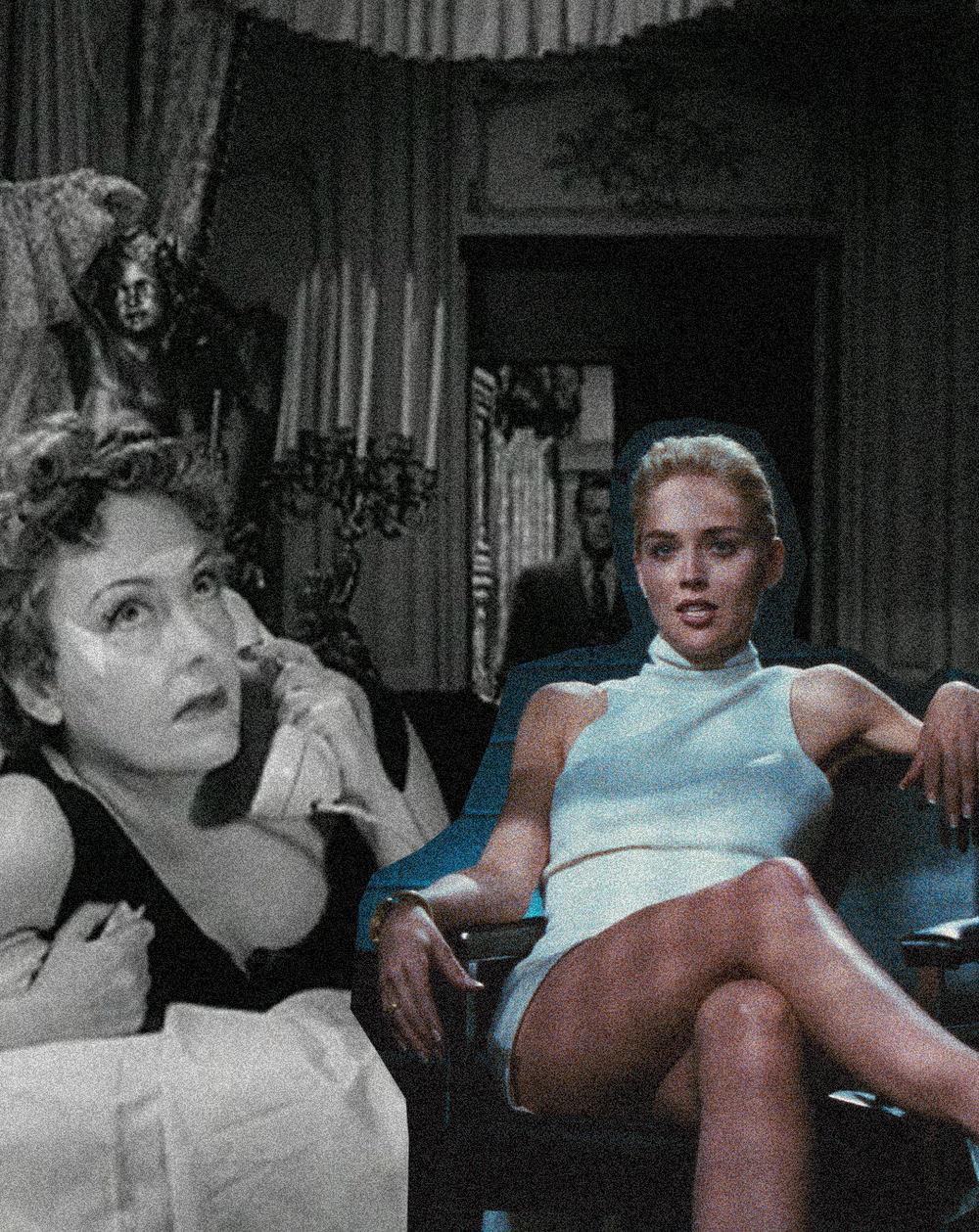Drop Dead Gorgeous: The Extreme Glamour and Ultra-Femininity of the Cinematic Evil Woman
Slender fingers with long nails, siren eyes and a dark lip, stocking and suspender-clad legs, sheer and suggestive negligee, dramatic eyewear and phallic cigarette holders; this is the uniform of the cinematic Evil Woman. Strutting across the genres, from Film Noirs to couples-who-kill, horror to dark comedies, the Evil Woman adorns herself in all manners of spectacular fashions and bold make-up, funded by her own financial independence or at the expense of foolish men. She indulges in her ultra-femininity to trick men for her personal gains and sexual pleasure, but ultimately her glamour and femininity is for the female gaze.
If we push aside her murderous tendencies, she should be an influential figure: independent, strong sense of self worth and confidence, successful career. Unfortunately when she is created by male directors, they fear her power, and so she must be destroyed.
Doused in sequins and sexual appetite, Norma Desmond, played by Gloria Swanson, from Sunset Boulevard (1950), is my favourite Evil Woman. Exuding maximalism with her siren eyes, luxurious outfits, and leopard-skin car seats, she lures failing screenwriter Joe Gillis - William Holden - into a web of money and lust, her spider-like hands beckoning him to pleasure with the return that he writes her comeback film.
Ms. Desmond should be the comeback queen, but that doesn’t align with Hollywood’s rampant ageism against women. Her maximalist sensibilities with fashion, sex and her career would also be too powerfully influential for post-war America’s strive for women’s return to the kitchen, the director must thrust delusions and murder upon her to justify the need to bring her down. It’s Hollywood gaslighting at its finest.
Unlike the femme fatales of the 1940s and 50s who are punished for being sexually free and not conforming to heteronormative standards, Sharon Stone’s Catherine Tramell from the ultimate raunchy neo-noir, Basic Instinct (1992), takes down and destroys anyone of her choosing with her sexual prowess. Very much the Hitchcock blonde – icy, neutral tones, enigmatic, seductive, smart – Catherine knows how to play with men’s fantasies, grab them by the proverbial balls and get away with her dirty deeds. Detective Nick, aka Michael Douglas, is so blinded by her sensuality and his desire for her that he cannot see that *spoiler* he is her next victim. Serves the sadomasochistic bastard right for referring to her as “the fuck of the century,” I’m glad the Hermès-loving Ice Queen wins.
The fashion in couples-who-kill films is an important part of the iconography and romanticism of the genre, so much so that with their tales of young love, you almost forget they’re on killing sprees. Leonard Kastle’s The Honeymoon Killers (1970), doesn’t quite follow suit, despite what the camptastic film posters suggest. Martha Beck (Shirley Stoler) and Ray Fernandez (Tony Lo Bianco) are plain and ordinary, which makes their killings colder and more sinister. But considering the film’s focus on Martha being unlovable by anyone other than a swindler who targets lonely ladies because of their weight, you wonder if cinema’s fatphobia wouldn’t romanticise her and her toupee-wearing husband. However, there is one scene where Martha embodies the Evil Woman. Lounging across a hotel bed in nothing but a lacy bed jacket with post-sex dishevelled hair, and seductively eating a box of chocolates, she is confident within herself and her relationship, therefore more powerful. From this point on, nothing comes between her and her man.
Similar to spiders, snake-like qualities feature heavily with the Evil Woman, none being more glamorously sexy than Lady Sylvia Marsh, Amanda Donohue, from Ken Russell’s The Lair of the White Worm (1988). With her blood-red, curved lips, snake-eye sunglasses, and crotch-high boot collection, Lady Sylvia slithers around the woods, searching for prey and a sacrificial virgin. While she might initially appeal to the sexual fantasies of men, she uses their lustful weakness to her personal and playful advantage. It is the female gaze that Lady Sylvia truly appeals to, with her to-die-for fashion sense which hark backs to Old Hollywood femme fatales with a kinky twist, as well as Ken Russell’s love for a cheeky bit of homoeroticism. I cannot stress enough how hypnotic and sexy she is.
“Sylvia’s sex-appeal, snake-like powers, huge strap-on and worship of an ancient worm are all too powerful for mankind and again, the strong woman archetype must be destroyed.”
Here is a reinvisioned Madonna-Whore complex - Sexy Snake Lady vs. Eve the Virgin Sacrifice, and though it's dealt in a tongue-in-cheek manner, the Whore cannot win. Sylvia’s sex-appeal, snake-like powers, huge strap-on and worship of an ancient worm are all too powerful for mankind and again, the strong woman archetype must be destroyed.
John Waters, the kind of all things bad taste, truly embraces the ultra-glamorous, ultra-feminine in Female Trouble, 1974. Divine’s teenage delinquent Dawn Davenport turns to a life of crime to fund her glamorous lifestyle of big hair, blue eyeshadow, and a sumptuous lingerie collection. After being scouted by fabulously bizarre salon owners, she is encouraged to take her crimes further for their art as “crime is beauty.” The hair, the outfits, the face and the crimes become so extreme that Dawn is sent to the electric chair: Her death could be viewed as comeuppance for her crimes, thus no different to the deaths of other Evil Women, however, Dawn doesn't see it that way. She has achieved her fifteen minutes of fame and reached the pinnacle of glamour. In death, her allure will last forever.
Words: Rosie Carter


